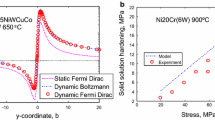Abstract
A simple model of creep crack growth, valid for creep-resistant alloys, is described. For such alloys, it may be assumed that the creep deformation is essentially confined to a thin region in the neighborhood of the crack tip. This thin region is modeled as a cohesive zone. Outside the cohesive zone, linear elastic conditions are assumed to prevail. Numerical results for both transient and steady-state crack growth are presented. For reasonable choices of model parameters, the numerical results show rather good agreement with experimental data.
Similar content being viewed by others
References
Barenblatt, G.I. (1962). The mathematical theory of equilibrium cracks in brittle fracture. Advances in Applied Mechanics 7, 55–97.
Bažant, Z.P. and Lin, Y.N. (1997). Cohesive crack with rate-dependent opening and viscoelasticity, I. Mathematical model and scaling. International Journal of Fracture 86, 247–266.
Bowen, P. and Hippsley, C.A. (1988). High temperature intergranular crack growth in martensitic 2\(2\frac{1}{4}\) Cr − 1 Mo steel. Acta Metallurgica 36, 517–526.
Carranza, F.L., Fang, B. and Haber, R.B. (1997). A moving cohesive interface model for fracture in creeping materials. Computational Mechanics 19, 517–521.
Carranza, F.L. and Haber, R.B. (1999). A numerical study of intergranular fracture and oxygen embrittlement in an elastic-viscoplastic solid. Journal of the Mechanics and Physics of Solids 47, 27–58.
Hippsley, C.A. (1987). Sulphur segregation and high-temperature intergranular fracture in alloy steels. Acta Metallurgica 36, 425–439.
Kameda, J. (1993). High temperature brittle intergranular cracking in high strength nickel alloys undoped and doped with S, Zr, and/or B, I. Crack growth characteristics. Acta Metallurgica 42, 517–526.
Lawn, B. (1993). Fracture of Brittle Solids (2nd edn), Cambridge University Press, Cambridge.
Lee, S.L. and Unger, D.J. (1988). A decohesion model of hydrogen assisted cracking. Engineering Fracture Mechanics 31, 647–660.
Nikbin, K.M. (1997). The role of creep damage and initiation in the failure of creep brittle materials. Creep and Fracture of Engineering Materials and Structures (Edited by J.C. Earthman and F.A. Mohamed), TMS, Warrendale, Pa (USA), 405–414.
Rice, J.R. and Wang, J.-S. (1989). Embrittlement of interfaces by solute segregation. Materials Science and Engineering A 107, 23–40.
Riedel, H. (1987). Fracture at High Temperatures. Springer-Verlag, Berlin.
Riedel, H. and Wagner, W. (1981). The growth of macroscopic cracks in creeping materials. Advances in Fracture Research — Proceedings of ICF5 (Edited by D. Francois et al.), Pergammon Press, Oxford, 683–688.
Riedel, H. and Wagner, W. (1985). Creep crack growth in nimonic 80A and in a 1 Cr − \(\frac{1}{2}\) Mo steel. Advances in Fracture Research '84 — Proceedings of ICF6 (Edited by S. Valluri et al.), Pergammon Press, Oxford, 2199–2206.
Schapery, R.A. (1975). A theory of crack initiation and growth in viscoelastic media, I. Theorietical development. International Journal of Fracture 11, 141–159.
Siegmund, T. and Needleman, A. (1997). A numerical study of dynamic crack growth in elastic-viscoplastic solids. International Journal of Solid and Structures 34, 769–787.
Stucke, M., Khobaib, M., Majumdar, B. and Nicholas, T. (1985). Environmental aspects in creep crack growth in a nickel base superalloy. Advances in Fracture Research — Proceedings of ICF5 (Edited by D. Francois et al.), Pergammon Press, Oxford, 3967–3975.
Tvergaard, V. and Hutchinson, J.W. (1992). The relation between crack growth resistance and fracture process parameters in elastic-plastic solids. Journal of the Mechanics and Physics of Solids 40, 1377–1397.
Wu, F.-H., Bassani, J.L. and Vitek, V. (1986). Transient crack growth under creep conditions due to grain-boundary cavitation. Journal of the Mechanics and Physics of Solids 34, 455–475.
Xu, X.-P. and Needleman, Alan (1994). Numerical simulations of fast crack growth in brittle solids. Journal of the Mechanics and Physics of Solids 42, 1397–1434.
Author information
Authors and Affiliations
Rights and permissions
About this article
Cite this article
Delph, T. A simple model for crack growth in creep resistant alloys. International Journal of Fracture 98, 77–86 (1999). https://doi.org/10.1023/A:1018717808350
Issue Date:
DOI: https://doi.org/10.1023/A:1018717808350



